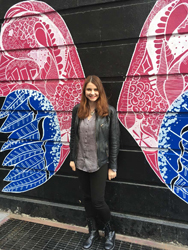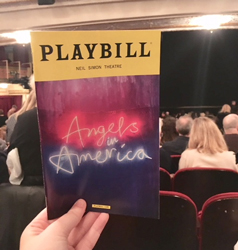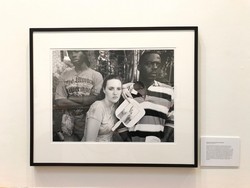The following review contains spoilers for Tony Kushner’s Angels in America.
To see Tony Kushner’s Angels in America is to do more than just see a play. The average Broadway show clocks in between two hours and two and a half hours, with one fifteen-minute intermission. Shows such as Les Miserables – which are closer to the three-hour mark – are considered behemoths; long-running plays such as Shakespeare’s works are often cut down by a scene or two.
Angels in America is told in nine acts over the course of two parts, subtitled Millennium Approaches and Perestroika. It more than doubles the run time of long shows like The Iceman Cometh and Shakespeare’s Hamlet – by the time all is said and done, the run time is almost eight hours.
In the hands of a lesser cast, sitting through such a long production could be a chore. Heavy, complex monologues make up the majority of the script, and Kushner’s prose is daunting at best.
The main action takes place in 1980s New York – though there are brief forays to Soviet Russia, Salt Lake City, and heaven itself – at the beginning of the AIDS epidemic; the illness affects every character as they struggle with their problems and try to cobble a life together in the face of great change.
However, in a cast of stars – largely the same cast from the acclaimed production at the National Theatre in London in the spring of 2017 – the play becomes intensely engaging and impossible to look away from.
With half a dozen lead actors and a set of dramatic, complex roles, each actor has more than enough work in their primary role.
To stop it there would evidently be too simple – instead, they each play several other bit parts, including nurses, lawyers, Antarctic tour guides, and the oldest Bolshevik in Russia.
To describe the nuances and humor of each role would take another thousand pages, so only their performances in their lead roles will be mentioned.
Nathan Lane plays real-life figure Roy Cohn, a closeted, cold-hearted attorney stricken by AIDS in the later acts of the production.
 In his early scenes, he is comedic and charismatic, but still a figure to be wary of.
In his early scenes, he is comedic and charismatic, but still a figure to be wary of.
As the acts and the illness wear on, he becomes less and less powerful, but still formidable. One phone call gets him a life-long supply of AZT drug treatments, which are only available to thirty people in the country due to their clinical-trial status; however, he remains haunted by the ghost of Ethel Rosenberg, a real-life Communist spy whose execution was championed by Cohn.
Roy Cohn is despicable and cold until his last moment – but Nathan Lane brings a needy desperation to the character, especially throughout Perestroika, where audiences see him ravaged by the illness that has claimed so many other lives.
If Nathan Lane is well-suited to the role of Roy Cohn, then the part of Prior Walter was all but written for Andrew Garfield.
Garfield played the role of campy, AIDS-infected drag queen Walter in London, and clearly has been involved with the role for so long that it has become a second skin for him.
The actor who is known for Spider-Man and Hacksaw Ridge all but vanishes into the character of Prior Walter, putting on a performance that will likely be recognized at this year’s Tony Awards ceremony.
Whether he is suffering in a hospital bed, appearing in full drag, or bargaining with actual angels, Garfield gives the performance his all in a way that is rarely as engaging as the one onstage at the Neil Simon. In one of the most complicated and difficult roles in the Western theatre canon, Garfield is entirely riveting and genuine.
Also worthy of acclaim is transplant Lee Pace, who was not a part of the London cast. He plays uptight Mormon Joe Pitt – who is also closeted, as well as being a Republican working at a clerk’s office.
Taken under Cohn’s wing, he finds his entire life upheaved by the effects of both the AIDS epidemic and his wife Harper’s Valium problem.
The other true genius in the cast is Denise Gough as Harper. While her Valium addiction may not be a relatable trait, her anxiety about everything – about imaginary murderers in her apartment, her fears about being trapped – is, and she adds welcome flavor to a storyline largely defined by the problems and flaws of male characters.
Her dependence on her husband is initially crippling; by the end of the show, she is flying alone to San Francisco to begin a new life in a rush of excitement that invigorates the audience – and at the tail end of an eight-hour production, that invigoration is welcome.
Other cast members – all stellar, all perfectly cast – include Nathan Stewart-Jarrett as Belize, a gay nurse who is close friends with Prior, and James McArdle as Louis, Prior’s lover who leaves him when his AIDS infection becomes too much.
Louis also enters a relationship with Joe, leaving them both distraught and potentially AIDS-infected; their status is never resolved.
Susan Brown plays Joe Pitt’s uptight Mormon mother, Hannah.
The other lead in the show changes based on the day. On Saturdays and Wednesdays Beth Malone plays The Angel; the remainder of the performances are played by Amanda Lawrence.
I saw the whole thing on a Saturday, with Malone on; and she is magnificent in the role. Both fearsome and pitiful as the commandeering yet shriveling Angel, she dominates the stage with huge wings and a distinctive personality, thrusting Prophet-dom upon the reluctant Prior.
A word about the Angels.
The plot line of Angels in America seems realistic, even simple – a community afflicted by AIDS and harmed by the Reaganite politics of the time does their best to grapple with the situation.
However, a plot line that simple would not take up eight hours. Instead, the whole thing gets a lot more complicated.
Throughout Millennium Approaches, Prior hears a disembodied voice and experiences dreams of two ancestors – both with the name Prior; he is the thirty-seventh family member to have the name – telling him that something is approaching.
Beyond that, the story remains mostly grounded – aside from the occasional pillar of fire, courtesy of Prior’s visions, and a hallucinatory foray to Antarctica, courtesy of Harper and her medications – until the very last moments of Part 2/Act III, when an Angel – fully embodied, with a ten-to-twelve foot wingspan – bursts through the ceiling in a crash of rubble and light.
In Perestroika, it is revealed that the Angel – a real, Biblical Angel – can no longer communicate with God; she and others of her kind believe that the only way to resolve the communication problem is to prevent the continuation of human advancement.
She names Prior her prophet, a role he eventually rejects as he enters heaven itself.
The production’s set design reverse-mirrors this turn towards surrealism in an extraordinary feat of creative work.
During the opening scenes – when the story is entirely grounded, taking place in apartments and offices with not a single angel feather in sight – the set design is bare and barren, with walls and doorways outlined only by flouerescent lights.
As the plot gets gradually more bizarre, the set becomes more defined – apartments and hospital rooms take shape; in one scene, the barren landscape of Antarctica – accompanied by truly beautiful lights and snow – appears; in another, a fully-realized diorama in a Mormon Visiting Center is at once realistic and surreal.
In the latter acts, as Prior confronts the Angels – again, literal biblical angels – the set is completely realized, with red curtains and flashing lights and golden fixtures.
As Prior, on the edge of death, pleads for more life, the set design reaches its height as objects affixed to the ceiling move.
And then it ends as quickly as it began. We return to the same basic, bare bones set design – Harper’s plane ride is marked by a single chair outlined in glowing purple light.
The final scene at the Bethesda fountain – yes, the one with the angel – has the fluorescent outline of the angel and water and nothing else. The characters stand on an empty stage, and as the lights dawn on a new millennium, the lights dawn on the audience as well.
Angels in America is an investment, both of time and of emotion. However, there is no better show on Broadway right now.
To see this show is to understand the AIDS epidemic in a way that is impossible to understand otherwise; seeing this show brings new life to a dark chapter in American history.
While you may leave the theater in contemplation, you will also leave it lifted – despite all its darkness and tragedy, the overwhelming message of Angels in America is one of “more life.”
PHOTOS TAKEN by Kerry Breen



